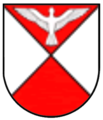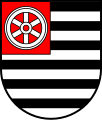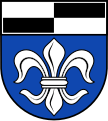Crossing (heraldry)
The crossing is in heraldry ( Heraldry ) as a shield dividing a special Herold image . Due to the unique split and division, the coat of arms is divided into four fields, which is also known as squaring . This vertical and horizontal division into so-called squares is one of the possible methods of combining coats of arms .
Basics

The origin was a desired association of coats of arms. Around 1230 it is first detectable in Spanish coats of arms. The peculiarity consists in the color and content of the coat of arms fields one and four, as well as two and three, so in the cross-wise fields the heraldic pictures and / or common figures are repeated . In the description of the coat of arms or blazon , this position is explained by embedding or squared .
| For fields with complex coats of arms, each field can also be addressed individually: embedding blue and gold. Field 1: or above ..., field 2: or in front ..., field 3: or behind ..., field 4: or below ... For fields in different or complex colors, these are included in the field description of the individual fields: obliquely square. 1: In blue one…, 2: Box red-gold…, 3: Split in silver and black… . This form is indispensable for the blazon of complex coats of arms. | |
| A diagonal division of this kind is an oblique squaring . The top color is mentioned first, then the heraldic right (front), the heraldic left (rear) color and finally the color on the base of the shield. | |
| The more and more frequent coats of arms associations made a so - called re - squaring necessary. Here the further division of the quartered fields took place, so that it soon led to confusion in many coats of arms. |
The example opposite ( Philip II of Spain as Prince Consort of Queen Maria Tudor, I of England 1554–1558) explains the problem of complex squaring, because it is not a quartered shield, but - a marriage coat of arms - a split one.
-
Front Philip (line of the Spanish Habsburgs): Divided.
-
Above the Crown of Spain - that is: Split.
- In front Castile and Leon - that is: Square of Castile (1st, 4th a tower) and Leon (2nd, 3rd a lion)
- At the back split by Aragon (gold-red divided) and Sicily - the second is: obliquely quartered Aragon (repeated) and Hohenstaufen (eagle)
- Sharpened below: Granada (pomegranate)
- Below, House of Habsburg-Burgundy - that is: Square with a heart sign: 1. Austria (red, one silver bar), 2. New Burgundy (lilies with red-silver border), 3. Old Burgundy (gold-blue diagonally with border red), 4. Brabant (a lion), applied split Flanders (a lion) and Tyrol (an eagle)
-
Above the Crown of Spain - that is: Split.
- Behind Maria (as Queen) - that is: quartered by France (1st, 4th three lilies) and England (2nd, 3rd three leopards)
The types of associations express their quality: the right (heraldic, front) part is Philip's personal claim, above his title, below his inheritance claims to the other Habsburgs , the rear the inheritance claims of his children with Mary (who did not exist). Castile and León (squared) have been a united kingdom since the Middle Ages (which is still valid today, merged in the Kgr. Spain), and squared France and England ( House Plantagenet ), is said to indicate the Norman claims to the Franks (after the Hundred Years War , what has not held). The crossing of the Habsburg inheritance is made up of the most important hereditary lands of the dynasty, the heart shield shows the current lineage of the time. Sicily diagonally square refers to the division of the old Norman Empire into the Staufer , then Aragonese Sicily , and Naples under Anjou , around 1380 (therefore reunited in 1816 to form the Kingdom of the Two Sicilies ). The current political situation as well as many centuries of European political history are expressed in a coat of arms and its partitions and associations. That is why the dynasty and territorial coats of arms were given names in order to abbreviate the blazon, the " Reichsadler " (double-headed eagle black on gold) is reduced in Sicily black on silver , the " Tyrolean eagle " is always red on silver , Habsburg / Austria the " Bindenschild ", or" France "(since the Middle Ages, previously sown like the Capetians ) always three golden lilies (2-1) on blue . That makes reading a coat of arms easier.
Derivatives of the crossing
The middle quadrant is the same conceptual and different in the representation . Here in a coat of arms a square field is arranged in the middle of the shield (at the heart ) and shows other heraldic images. This method is similar to the heart shield .
If such a field is moved to the upper corner of the shield (the upper corner ), it becomes a free quarter, which then gains independence in its shape and can also deviate from the quarter of the shield (small crossing, light corner, free corner ).
The additional division and division into six fields also belongs in this herald's picture. The first, third and fifth fields on the one hand and the second, fourth and sixth fields on the other matched.
Then the crossing also became a simple method of tinging (coloring) and can be applied to any figure - heraldic image as well as common figure , i.e. a bar quartered with gold and black.








